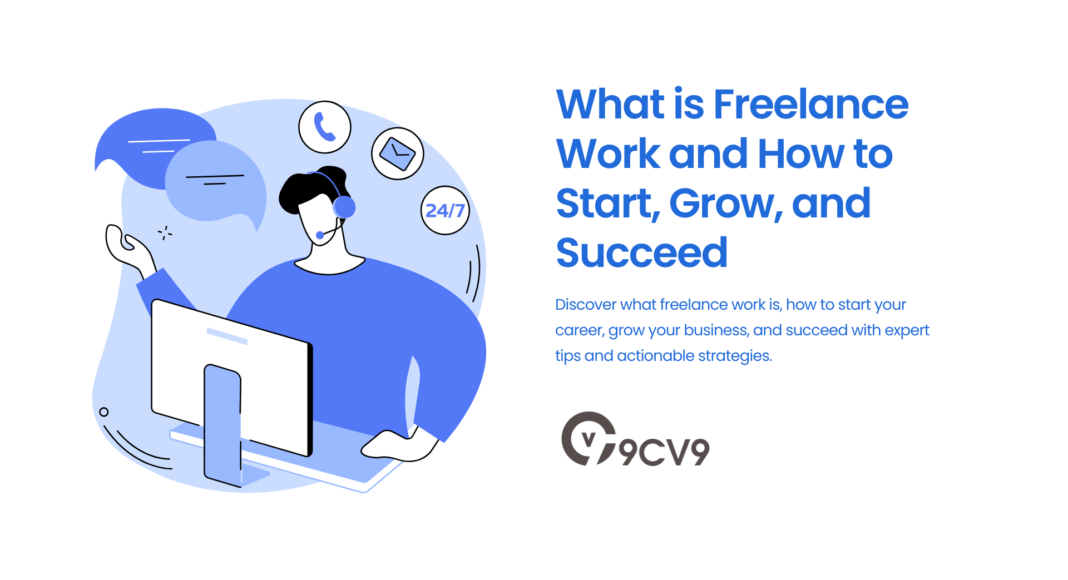Key Takeaways
- Understanding Freelance Work: Freelancing offers flexibility, independence, and diverse opportunities across industries, allowing individuals to monetize their skills globally.
- Starting Your Freelance Career: Success begins with identifying a niche, creating a strong online presence, and networking to secure initial projects and build credibility.
- Growing and Thriving as a Freelancer: Scale your business by delivering exceptional value, leveraging tools for efficiency, and continuously upskilling to stay competitive in the evolving market.
Freelance work has rapidly become one of the most sought-after career paths in the modern workforce, driven by the growing desire for flexibility, autonomy, and the ability to work from anywhere.
Whether you’re looking to supplement your income, escape the confines of a 9-to-5 job, or build a full-time business, freelancing offers endless opportunities to pursue a diverse range of projects across various industries.
In fact, recent trends show that millions of people around the world are transitioning from traditional employment to freelancing, fueled by technological advancements, a shift in work culture, and the rise of digital platforms that connect freelancers with clients globally.

But what exactly is freelance work?
At its core, freelancing means offering your services to clients on a project-by-project basis, without being tied to a long-term employer.
Freelancers typically operate as independent contractors, managing their own business operations, setting their own rates, and choosing the projects that align with their skills and interests.
Unlike traditional employment, which often includes fixed schedules, benefits, and job security, freelancing provides greater flexibility and control over how and when you work.
While this freedom can be incredibly appealing, it also comes with its own set of challenges, including inconsistent income, client acquisition, and self-management responsibilities.
This blog aims to provide a comprehensive guide to understanding freelance work, as well as actionable insights on how to start, grow, and succeed in your freelance career.
Whether you’re just considering freelancing or you’re already established and looking to scale, the steps outlined here will help you navigate the path to success.
From identifying your niche and building a strong online presence to managing your time and finances effectively, we’ll cover everything you need to know to make your freelancing journey a rewarding and sustainable one.
With the right strategies, a solid skillset, and the drive to succeed, you can tap into the thriving gig economy and turn your freelance career into a fulfilling, long-term venture.
In this guide, we’ll walk you through each phase of the freelancing process—from the first steps of setting up your business to the strategies that will allow you to build a strong client base, continuously grow your skills, and overcome the obstacles that come with this unique career choice.
By the end of this post, you’ll have all the tools and knowledge necessary to start your freelancing journey with confidence and achieve long-term success.
Before we venture further into this article, we would like to share who we are and what we do.
About 9cv9
9cv9 is a business tech startup based in Singapore and Asia, with a strong presence all over the world.
With over eight years of startup and business experience, and being highly involved in connecting with thousands of companies and startups, the 9cv9 team has listed some important learning points in this overview of What is Freelance Work and How to Start, Grow, and Succeed.
If your company needs recruitment and headhunting services to hire top-quality employees, you can use 9cv9 headhunting and recruitment services to hire top talents and candidates. Find out more here, or send over an email to [email protected].
Or just post 1 free job posting here at 9cv9 Hiring Portal in under 10 minutes.
What is Freelance Work and How to Start, Grow, and Succeed
- What is Freelance Work?
- How to Start Your Freelance Career
- How to Grow Your Freelance Business
- How to Succeed as a Freelancer
1. What is Freelance Work?

Freelance work is a flexible and independent form of employment where individuals offer their services to clients on a project-by-project basis rather than being employed by a single employer on a permanent basis.
Freelancers typically work for multiple clients, manage their own schedules, and have the freedom to choose the type of work they want to pursue.
In today’s increasingly digital world, freelancing has become a viable career path for people across a wide range of industries.
Understanding Freelance Work
- Definition and Structure
- Freelancers are self-employed individuals who provide services to clients for specific projects or tasks.
- Unlike traditional employees, freelancers do not have long-term contracts with a single employer.
- They work on a per-project or hourly basis, often with flexible schedules and varied work locations.
- Key Features of Freelance Work
- Independence: Freelancers are their own bosses, allowing them to have control over their workload, rates, and work environment.
- Project-Based Work: Freelancers typically work on short-term or long-term projects with specific deliverables rather than ongoing roles.
- Variety of Clients: Freelancers can work with multiple clients at once, providing a diverse and dynamic work experience.
- Flexibility: Freelancers enjoy the ability to work from home or any location, providing an excellent work-life balance.
Freelance Work vs. Traditional Employment
- Employment Status
- Freelancers are independent contractors responsible for their own taxes, benefits, and retirement planning.
- Traditional Employees work full-time or part-time for one company and receive benefits like health insurance, paid leave, and retirement plans.
- Flexibility and Control
- Freelancers set their own schedules and can accept or reject projects based on their preferences.
- Traditional employees have set working hours and must adhere to their employer’s schedules and policies.
- Income and Stability
- Freelancers experience income variability, as their earnings depend on the number and scope of projects they complete.
- Traditional employees typically have a consistent salary and more financial stability, though they have less control over how much they can earn.
Types of Freelance Jobs
Freelance work spans across a wide range of industries and professions, offering ample opportunities for individuals to utilize their skills and expertise. Some common freelance job categories include:
- Creative and Design Work
- Graphic Designers: Create visual content for brands, websites, and advertisements.
- Web Designers and Developers: Build websites and online platforms for businesses, organizations, and individuals.
- Illustrators and Animators: Provide custom illustrations and animations for books, videos, and advertisements.
- Photographers: Offer freelance photography services for events, marketing, or product shoots.
- Writing and Content Creation
- Copywriters: Write persuasive and informative content for websites, advertisements, and social media.
- Editors and Proofreaders: Review and refine written content for clarity, grammar, and style.
- Bloggers and Journalists: Produce original content on specific topics, ranging from lifestyle to business to technology.
- Technical Writers: Create manuals, guides, and other technical documentation for software, machinery, and more.
- Marketing and Social Media Management
- Social Media Managers: Manage social media accounts for businesses, including content creation, audience engagement, and analytics.
- SEO Specialists: Optimize websites to rank higher in search engine results, driving organic traffic and improving visibility.
- Email Marketing Experts: Design and implement email campaigns that engage customers and drive sales.
- Consulting and Coaching
- Business Consultants: Advise companies on improving operations, strategies, and financial management.
- Life Coaches: Provide personal coaching services to individuals seeking guidance in their careers or personal lives.
- Financial Advisors: Offer expert advice on budgeting, investment, and wealth management for clients.
- Technology and Development
- Software Developers: Create custom applications, websites, or software solutions for clients in various industries.
- Mobile App Developers: Design and develop applications for smartphones and tablets.
- Cybersecurity Experts: Help businesses protect their data and networks from cyber threats.
- IT Support Technicians: Offer remote support and troubleshooting for businesses or individuals needing technology assistance.
Skills in Demand for Freelancers
To be successful as a freelancer, it’s essential to have a mix of technical skills and business acumen. While the specific skills needed will depend on your field, some general competencies are highly sought after:
- Creative Skills
- Graphic design, video editing, and visual arts.
- Photography, illustration, and animation.
- Communication Skills
- Clear and effective communication is crucial for collaborating with clients and meeting project expectations.
- Freelancers must be able to write emails, create proposals, and present ideas persuasively.
- Technical Skills
- Programming languages like JavaScript, Python, and HTML/CSS.
- SEO, web development, mobile app development, and digital marketing.
- Project Management Skills
- Freelancers often need to manage multiple projects simultaneously.
- Being organized, setting deadlines, and communicating effectively with clients are essential skills for time management and successful project delivery.
Examples of Freelance Work in Action
- Graphic Designer Example
- Sarah, a freelance graphic designer, specializes in logo design. She works with several startups, creating their brand identities. By building an online portfolio and networking through platforms like LinkedIn and Upwork, she secured multiple clients and has grown her business steadily over the past two years.
- Web Developer Example
- John is a freelance web developer who builds custom websites for small businesses. He found his first client through a local networking event and later expanded his client base by joining platforms such as Toptal and GitHub. John now has a steady stream of clients and often collaborates with other developers to handle large projects.
- Copywriting Example
- Lisa, a freelance copywriter, specializes in writing blog posts and website copy for e-commerce brands. After creating a blog to showcase her writing and using social media to attract clients, she has built a robust client base and transitioned into full-time freelancing.
Conclusion
Freelance work offers a world of opportunity, providing individuals with the chance to take control of their careers and achieve a level of flexibility that is unmatched in traditional employment.
Whether you’re working in the creative arts, technology, marketing, or any other industry, the rise of freelancing has opened up numerous avenues for professionals to showcase their expertise, work with diverse clients, and build successful, independent careers.
With the right combination of skills, determination, and strategy, anyone can tap into the power of freelancing and carve out their path to professional success.
2. How to Start Your Freelance Career

Starting a freelance career can feel like a daunting task, but with the right approach and a clear roadmap, you can set yourself up for success.
Freelancing offers tremendous flexibility, but it also requires dedication, self-discipline, and a solid strategy.
In this section, we’ll walk you through the essential steps to help you launch and grow your freelance career. From identifying your niche to building a portfolio and securing clients, we’ll cover everything you need to know.
Step 1: Identify Your Skills and Niche
Before diving into the world of freelancing, it’s essential to evaluate your skills and choose a niche that not only suits your strengths but also has demand in the market. Here’s how to approach this step:
- Assess Your Strengths
- List out the skills and expertise you’ve gained from previous jobs, education, and personal projects.
- Consider both hard skills (e.g., coding, graphic design) and soft skills (e.g., communication, time management).
- Identify areas where you have a competitive edge, such as specialized knowledge in a certain industry or proficiency with high-demand tools.
- Research Market Demand
- Conduct research to determine which niches have high demand in the freelance market. Some lucrative freelance niches include:
- Tech: Web development, software engineering, mobile app development.
- Creative: Graphic design, video production, photography.
- Content: Copywriting, blogging, SEO writing.
- Marketing: Social media management, SEO optimization, email marketing.
- Use platforms like Upwork, Fiverr, and LinkedIn to see what types of freelance jobs are in demand.
- Conduct research to determine which niches have high demand in the freelance market. Some lucrative freelance niches include:
- Define Your Niche
- Specializing in a niche helps you stand out and attract clients who are specifically looking for your skills. For example, rather than just offering “graphic design,” you might choose to specialize in “logo design for e-commerce brands.”
- A defined niche allows you to target your marketing efforts and charge premium rates due to your expertise in a specific area.
Step 2: Build a Professional Portfolio and Online Presence
A strong portfolio is critical in attracting clients and showcasing your expertise.
Your portfolio should demonstrate the quality of your work and help clients understand what you offer.
Here’s how to build an effective portfolio:
- Create a Portfolio Website
- Set up a professional website that serves as your portfolio. Platforms like Wix, Squarespace, or WordPress offer easy-to-use templates to get started.
- Include sections such as:
- About Me: Briefly describe your experience, background, and the services you offer.
- Portfolio: Showcase your best work. If you’re just starting and don’t have client work yet, create mock projects or volunteer your services for nonprofits to build your portfolio.
- Testimonials: Display feedback from clients or colleagues to build credibility.
- Contact Information: Make it easy for potential clients to reach you.
- Leverage Freelance Platforms
- Join well-known freelance platforms such as Upwork, Freelancer, and Fiverr. These platforms allow you to showcase your skills, bid on projects, and connect with clients worldwide.
- Make sure your profile is professional and includes:
- A clear and compelling description of your services.
- A portfolio of your work (you can upload images, videos, or documents).
- Client testimonials (if you have any).
- Develop Your Online Presence
- Establish your presence on social media platforms, especially LinkedIn, to connect with potential clients and peers. Share your expertise by posting relevant content, such as articles, case studies, or insights from your work.
- Consider joining niche communities and freelance groups on platforms like Facebook or Reddit to network with fellow freelancers and potential clients.
Step 3: Set Your Rates and Define Your Services
As a freelancer, you need to establish a clear pricing structure that reflects the value of your services while staying competitive. Here’s how to determine your rates:
- Research Industry Rates
- Conduct market research on typical freelance rates for your niche. Websites like Glassdoor, PayScale, and freelance platforms like Upwork can give you an idea of what others in your field are charging.
- Keep in mind factors like your level of experience, the complexity of the project, and the market demand for your services.
- Pricing Models to Consider
- Hourly Rate: Charge per hour worked. This is common for tasks like writing, design, or consulting.
- Project-Based Rate: Charge a flat fee for the completion of a project. This works well for design, web development, and other tasks with clearly defined deliverables.
- Retainer: Offer clients a monthly retainer fee for ongoing work. This provides consistent income and is ideal for tasks like social media management or SEO services.
- Define Your Services Clearly
- List the specific services you offer and avoid being too vague. For example, instead of just offering “writing services,” you might offer “SEO-focused blog writing” or “technical writing for software documentation.”
- Be transparent about what is included in each service package to avoid scope creep and ensure clients know exactly what they’re paying for.
Step 4: Start Finding Clients
Once your portfolio is ready, and your rates are set, it’s time to find clients. Here are effective strategies to begin building your client base:
- Use Freelance Job Boards
- Platforms like Upwork, Freelancer, and Fiverr are great places to find job postings in your niche. Regularly check these platforms and submit proposals to relevant job listings.
- Be sure to write personalized proposals, highlighting how your skills can solve the client’s problems and demonstrating why you’re the right person for the job.
- Network and Build Relationships
- Attend networking events and conferences (both in-person and virtual) related to your niche.
- Reach out to your existing network (friends, colleagues, former employers) and let them know you’re offering freelance services. Many freelance gigs come through referrals.
- Use LinkedIn to connect with potential clients, and send them thoughtful messages introducing yourself and offering your services.
- Leverage Social Media
- Share your work on platforms like Instagram, Twitter, or Behance (if you’re in a creative field).
- Use hashtags and geotags to increase visibility and reach your target audience.
- Consider writing articles or blog posts on platforms like Medium or LinkedIn, demonstrating your expertise and attracting inbound clients.
- Cold Outreach
- If you have a target list of companies or individuals you want to work with, don’t hesitate to reach out directly. Craft a well-written email introducing yourself and explaining how your services can benefit them.
- Personalize each email by referencing their business or mentioning a specific project you’ve worked on that relates to their needs.
Step 5: Manage Your Freelance Business
As you begin to take on more projects, it’s important to manage your freelance business effectively:
- Time Management
- Use project management tools like Trello, Asana, or Notion to track deadlines, client requirements, and progress on various tasks.
- Set aside specific work hours each day, especially if you’re freelancing full-time, to maintain productivity.
- Financial Management
- Keep track of your earnings and expenses using tools like QuickBooks or FreshBooks.
- Set aside money for taxes, as freelancers are responsible for their own tax payments. You may also want to consult with an accountant to ensure you’re compliant with tax laws.
- Consider saving for retirement by opening a SEP IRA or Solo 401(k), as freelancers are not eligible for employer-sponsored retirement plans.
Conclusion
Starting your freelance career may seem overwhelming at first, but by breaking the process down into clear steps, you can build a strong foundation for a successful freelance business.
From identifying your niche and building a professional portfolio to finding clients and managing your work-life balance, each step is crucial in creating a sustainable freelance career.
By staying focused, continuously improving your skills, and leveraging online platforms, you’ll be well on your way to establishing yourself as a successful freelancer.
3. How to Grow Your Freelance Business
Growing a freelance business requires a strategic approach, continuous learning, and proactive efforts to expand your client base, raise your rates, and build a sustainable income stream.
As you progress from getting started to becoming an established freelancer, there are key actions and tactics you can take to elevate your freelance career.
This section outlines actionable steps and strategies for growing your freelance business and achieving long-term success.
Step 1: Focus on Building Long-Term Client Relationships
While acquiring new clients is crucial, retaining clients and nurturing long-term relationships is just as important. Repeat business is a major contributor to consistent income in freelancing. Here’s how you can build lasting relationships with clients:
- Exceed Client Expectations
- Deliver high-quality work that meets or exceeds client expectations. Pay attention to detail and consistently meet deadlines.
- Go the extra mile by offering additional insights or solutions to problems your client faces. For example, if you’re a web developer, suggest SEO optimizations that could improve the site’s performance.
- Communicate Effectively
- Maintain clear, transparent communication with your clients. Regular updates on progress, and asking questions when needed, shows professionalism and helps prevent misunderstandings.
- Be responsive to emails and messages. Clients appreciate freelancers who are easy to communicate with and who keep them in the loop throughout the project.
- Offer Ongoing Support
- Offer clients a post-project follow-up or maintenance services to help them with any future needs.
- For example, if you’re a designer, you can offer clients a monthly retainer for ongoing design work, such as social media graphics or promotional materials.
- Ask for Referrals
- After successfully completing a project, don’t hesitate to ask satisfied clients for referrals. Personal recommendations can be a valuable source of new clients.
- Encourage clients to provide testimonials or reviews that you can use to showcase your expertise on your portfolio or freelance platforms.
Step 2: Diversify Your Client Base and Income Streams
Expanding your client base and diversifying your income streams is essential for business growth. Relying on a small number of clients can make your business vulnerable. Here are ways to achieve diversification:
- Target Different Industries
- While you might specialize in one area, such as writing or graphic design, try to work with clients from various industries to broaden your exposure.
- For instance, a freelance copywriter could work with clients in tech, healthcare, education, and e-commerce to reduce the risk of market saturation in one niche.
- Explore Different Services
- Offer additional services to your existing clients, expanding your value proposition. For example, if you’re a web developer, consider offering SEO services, content writing, or website maintenance.
- By offering a broader range of services, you increase the chances of your clients coming back for more, thus reducing the need to find new clients constantly.
- Work on Retainers
- Instead of always hunting for new project-based work, negotiate retainer contracts with clients for ongoing projects. For instance, a freelance social media manager can secure a monthly retainer fee for consistent content creation and strategy updates.
- Retainers provide reliable monthly income and help you stabilize your cash flow, ensuring you’re not reliant on one-off projects.
- Join Multiple Freelance Platforms
- To increase visibility and attract a diverse range of clients, join multiple freelance platforms like Upwork, Fiverr, Toptal, and Freelancer. Different platforms attract different client demographics.
- Customize your profile for each platform to cater to the target audience. For example, Upwork tends to attract long-term clients, while Fiverr may bring in one-off gigs for quick services.
Step 3: Increase Your Rates as You Gain Experience
As you gain more experience and build a stronger portfolio, it’s time to raise your rates. Charging higher rates reflects your value and expertise, and it can also help you attract more serious clients. Here’s how to approach rate increases:
- Assess Your Skills and Experience
- With each completed project, reflect on how your skills have improved and how you’ve learned new tools or techniques. With this added expertise, you’re in a position to justify higher rates.
- For example, a freelance graphic designer who has learned advanced techniques in motion graphics or 3D modeling can increase their hourly rate to reflect their expanded skill set.
- Evaluate Market Rates
- Regularly research the market to understand what others in your field are charging. Websites like Glassdooror PayScale offer useful data on industry standards.
- Consider the value you bring to clients. For example, if your work results in measurable business growth, such as increased website traffic, you can justify charging premium rates.
- Be Transparent with Clients
- When increasing your rates, be upfront and transparent with clients. Explain why you’re raising your rates, whether it’s due to increased expertise, higher demand, or inflation.
- For example, you could say, “I’ve gained additional experience in SEO optimization and data analytics, which will significantly enhance the results I provide for your project. As a result, my rates will increase starting next month.”
- Offer Tiered Pricing Options
- For clients who may be hesitant about rate increases, offer tiered pricing based on the complexity of the work. For instance, basic web design packages can be offered at a lower rate, while premium packages that include additional services, such as SEO, come at a higher rate.
- This allows clients to choose an option that fits their budget, while still providing opportunities for upselling more comprehensive services.
Step 4: Invest in Your Professional Development
Continually investing in your skills and staying updated with industry trends is essential for staying competitive and offering the best services to your clients. Here’s how to invest in your professional growth:
- Take Online Courses
- Websites like Udemy, LinkedIn Learning, and Coursera offer affordable and flexible courses on a wide range of topics. Whether it’s a specific software tool or a broader business management course, regularly upgrading your skills ensures you stay relevant.
- For example, a freelance photographer could take courses in advanced editing techniques or video production to expand their offerings to clients.
- Attend Workshops and Webinars
- Participate in industry-related workshops, webinars, and conferences to learn from experts, network with peers, and stay updated with emerging trends in your field.
- For instance, a freelance writer can attend writing workshops to enhance their craft, while a web developer might attend conferences on the latest coding languages or tools.
- Seek Feedback and Mentorship
- Regularly seek feedback from clients, colleagues, or mentors to identify areas for improvement. Constructive criticism helps you refine your skills and grow professionally.
- Join online communities or freelance groups where you can ask for advice and share experiences with fellow freelancers.
Step 5: Expand Your Marketing and Networking Efforts
As your freelance business grows, expanding your marketing and networking efforts will help you build visibility and attract high-value clients. Here’s how to take your marketing strategy to the next level:
- Content Marketing
- Start a blog or create content on platforms like Medium, LinkedIn, or your personal website to showcase your expertise. Writing about your industry trends, challenges, or case studies helps you establish authority and attract clients.
- For instance, a freelance marketer could write blog posts about the latest digital marketing strategies, providing value to potential clients and positioning themselves as an expert.
- Leverage Social Media Advertising
- Utilize paid advertising on social media platforms like Facebook, Instagram, or LinkedIn to reach a broader audience. Ads can promote your services or showcase your portfolio.
- If you’re a freelance web designer, you could run ads targeting small businesses looking to revamp their websites, highlighting your work in your ad creatives.
- Engage in Networking
- Networking is critical to growing your freelance business. Join relevant professional groups, forums, and social media communities in your niche.
- Participate in virtual networking events, industry meetups, or online collaborations. Building relationships with other freelancers and potential clients is essential for long-term growth.
- Collaborate with Other Freelancers
- Form partnerships with other freelancers who offer complementary services. For example, a freelance writer could collaborate with a web designer to offer bundled services to clients, such as copywriting and website design.
- Collaboration allows you to expand your reach and access clients who might need a wider range of services.
Conclusion
Growing your freelance business is a continual process of improving your skills, expanding your client base, and refining your business strategies. By focusing on building long-term client relationships, diversifying your services, increasing your rates, investing in professional development, and enhancing your marketing efforts, you can scale your freelance business and achieve long-term success. With time and persistence, you’ll not only grow your business but also enjoy the freedom and flexibility that freelancing provides.
4. How to Succeed as a Freelancer
Success in freelancing is not just about having a skill or delivering high-quality work.
It requires strategic planning, business acumen, and the ability to adapt to the constantly changing landscape of the freelance world.
To truly thrive as a freelancer, it’s essential to combine professional expertise with smart business practices. This section outlines actionable steps and key strategies to help you succeed in the competitive freelance market.
Step 1: Develop a Strong Personal Brand
Building a strong personal brand is essential for standing out in the crowded freelance market. Your brand defines how clients perceive you and is a reflection of your values, expertise, and the services you offer. Here’s how to develop a strong personal brand:
- Create a Professional Online Portfolio
- Showcase your best work in an organized and visually appealing portfolio. This is the first thing potential clients will look at when deciding whether to hire you.
- If you’re a freelance graphic designer, include a variety of design samples that demonstrate your range—from logos to brochures and web design.
- Define Your Niche
- Specializing in a niche helps differentiate you from the competition. By focusing on a specific industry or skill, you can become an expert and attract clients who need specialized services.
- For example, a freelance writer might specialize in technical writing for the tech industry or content creation for health and wellness brands.
- Build a Consistent Online Presence
- Be active on social media platforms like LinkedIn, Twitter, Instagram, or YouTube. Share valuable content related to your area of expertise to position yourself as a thought leader.
- A freelance digital marketer, for instance, could share industry insights, case studies, or tips on increasing online visibility through social media, SEO, and paid advertising.
- Use Testimonials and Case Studies
- Client testimonials and detailed case studies are powerful tools for showcasing your expertise and building trust with potential clients.
- After completing a project, ask your clients for a testimonial. If possible, work with them to create a case study outlining the problem, your solution, and the results.
Step 2: Manage Your Time and Workload Effectively
Freelancers must manage their time efficiently to juggle multiple clients, meet deadlines, and maintain a work-life balance. Time management is a critical factor for success in freelancing. Here’s how to do it:
- Set Clear Boundaries
- One of the challenges of freelancing is the lack of a fixed schedule. Set clear boundaries to avoid burnout and ensure a healthy work-life balance.
- For example, avoid working late into the evening or on weekends unless it’s absolutely necessary. Set work hours and communicate these to your clients.
- Use Time-Tracking Tools
- Tools like Toggl, Harvest, or Clockify help you track time spent on different tasks. This is essential for billing clients accurately and ensuring you’re not overworking.
- Time tracking also helps you identify inefficiencies in your workflow and make adjustments to improve productivity.
- Prioritize Your Tasks
- Use productivity techniques like Eisenhower Matrix or the Pomodoro Technique to prioritize tasks and break your work into manageable chunks.
- For instance, if you’re a freelance web developer, break down a complex website project into smaller tasks, such as design, development, testing, and deployment, and prioritize each phase.
- Set Realistic Deadlines
- Always set realistic deadlines for your projects and be transparent with clients if you need more time. Avoid overcommitting and underdelivering.
- For example, a freelance writer can inform a client about realistic delivery times after considering current workload, research time, and revisions.
Step 3: Offer Exceptional Client Service
Delivering excellent client service is essential for retaining clients, gaining referrals, and building a sustainable freelance business. Here’s how to exceed client expectations:
- Understand Your Client’s Needs
- Take the time to understand your client’s goals, challenges, and expectations before starting a project. Asking the right questions will help you tailor your services to their specific needs.
- For instance, a freelance photographer can ask about the client’s vision for a photo shoot, the mood or theme they want to achieve, and the intended use of the images.
- Communicate Regularly
- Regular communication throughout the project ensures the client is kept in the loop and prevents any last-minute surprises.
- Send progress updates, ask for feedback, and provide suggestions to improve the outcome. If there are delays or challenges, notify the client promptly and provide solutions.
- Exceed Expectations
- Go above and beyond for your clients by delivering more than what was initially agreed upon, such as offering a bonus service or additional work.
- A freelance developer might deliver a feature not initially discussed or offer post-launch support for a set period, ensuring the client is satisfied with the final result.
- Be Professional and Reliable
- Demonstrate professionalism by meeting deadlines, being polite, and maintaining a positive attitude throughout your client interactions.
- Reliability is key in freelancing; clients value freelancers who consistently deliver high-quality work on time. It builds trust and encourages repeat business.
Step 4: Continuously Improve Your Skills
The freelance market is constantly evolving, and staying ahead of the curve is vital for long-term success. Continuously improving your skills helps you remain competitive and able to offer clients the best possible solutions.
- Invest in Learning and Development
- Dedicate time each month to improving your skills. This can involve taking online courses, attending webinars, or reading industry-related books.
- For instance, a freelance copywriter could take a content marketing course to learn more about SEO, while a freelance graphic designer might take a course in user experience (UX) design.
- Stay Updated with Industry Trends
- Follow relevant blogs, podcasts, and forums to keep up with the latest trends, tools, and best practices in your field.
- A freelance social media manager, for example, could follow influencers in the digital marketing space to stay informed about algorithm changes and new tools.
- Experiment with New Tools and Techniques
- Don’t be afraid to experiment with new tools, platforms, and techniques. By doing so, you can offer your clients the latest solutions that improve their outcomes.
- If you’re a freelance videographer, for example, experimenting with emerging video editing software like Adobe Premiere Pro or Final Cut Pro can enhance your work quality.
Step 5: Network and Build Relationships
Networking is a crucial part of freelancing, as it helps you find clients, collaborators, and opportunities for growth. Building relationships within your industry can create more work opportunities and help you scale your freelance business.
- Attend Networking Events
- Join both online and offline networking events, conferences, and workshops to meet potential clients and fellow freelancers. For example, a freelance consultant might attend industry-specific conferences or meetups to network with decision-makers.
- Use these events to not only pitch your services but also build genuine relationships by offering value to others in your industry.
- Engage on Social Media
- Be active on social media platforms where your target audience hangs out. Join groups, comment on relevant posts, and share insights that reflect your expertise.
- For instance, a freelance web developer could participate in discussions about best coding practices or share useful coding tips on GitHub or Stack Overflow.
- Collaborate with Other Freelancers
- Teaming up with other freelancers who complement your skills is an effective way to take on larger projects or expand your service offerings.
- For example, a freelance copywriter could collaborate with a graphic designer to offer a complete package of content and visuals for a marketing campaign.
- Build Relationships with Clients
- Cultivate strong, long-term relationships with existing clients to encourage repeat business and referrals. Regular check-ins, thank-you notes, or offering free consultations for new projects are excellent ways to stay top of mind.
- For example, after completing a project, a freelance content creator can send clients periodic updates or newsletters on industry trends that might benefit their business.
Step 6: Manage Your Finances and Taxes Wisely
A significant part of freelancing success comes from managing your finances effectively. Freelancers often face irregular income, so having a solid financial plan and understanding taxes is essential for long-term sustainability.
- Set Aside Money for Taxes
- Unlike salaried employees, freelancers are responsible for their own taxes. Set aside a portion of your income for tax purposes, typically around 20-30%, depending on your tax bracket.
- Use tools like QuickBooks or FreshBooks to track your earnings and expenses, ensuring you have the right amount for tax payments at the end of the year.
- Save for Slow Periods
- Freelancers experience periods of feast and famine. Save a percentage of your income during busy months to ensure you have enough to cover living expenses during lean months.
- Open a separate savings account for your freelance earnings to keep your business and personal finances separate.
- Set a Budget
- Create a detailed budget to track your business expenses, including software subscriptions, marketing costs, website maintenance, and other overheads.
- Keeping a tight budget will ensure you’re operating profitably and can help prevent financial stress during slower periods.
Conclusion
Success as a freelancer requires a combination of strategy, consistency, and adaptability. By developing a strong personal brand, managing your time effectively, delivering exceptional client service, continually improving your skills, networking, and managing your finances wisely, you can not only succeed but thrive in the competitive freelance market. With dedication and the right approach, freelancing can offer unparalleled freedom and financial rewards.
Conclusion
Freelance work is more than just a career choice—it’s a lifestyle that offers unparalleled flexibility, creativity, and autonomy. As industries worldwide embrace the benefits of remote and project-based work, freelancing continues to grow as a viable and fulfilling career option for millions. However, achieving long-term success as a freelancer requires a clear roadmap, a commitment to excellence, and the ability to adapt to the ever-evolving demands of the market.
Understanding Freelance Work: The Foundation of Your Career
The journey begins with understanding what freelance work truly entails. Freelancing isn’t just about working independently; it’s about creating value for clients while building a sustainable and fulfilling career for yourself. Whether you’re a graphic designer, writer, consultant, or software developer, freelancing allows you to harness your skills and transform them into a profitable business.
Key points to remember:
- Freelancing offers flexibility and independence, making it ideal for those seeking control over their schedules.
- It’s a global phenomenon, giving you access to clients and opportunities worldwide.
- Freelancing requires self-motivation, discipline, and the ability to handle multiple roles, from marketing to project management.
Starting Strong: Laying the Groundwork for Your Freelance Career
Starting a freelance career may seem daunting, but with the right steps, you can transition seamlessly into this dynamic work model. From identifying your niche to building an online portfolio, every action you take at the beginning sets the stage for long-term success.
Important steps to consider:
- Research your market and define a niche that aligns with your expertise and passion.
- Build a professional portfolio and optimize your online presence to attract clients.
- Use freelancing platforms and networking opportunities to secure your first projects.
By starting with a strategic approach, you can establish a solid foundation that helps you stand out in a competitive landscape.
Growth Strategies: Taking Your Freelance Business to the Next Level
Once your freelance career is off the ground, the focus shifts to growth. Scaling your freelance business involves not just increasing your client base but also optimizing your processes, enhancing your skill set, and leveraging tools that improve productivity.
Growth tips include:
- Expanding your network to find long-term clients and partnerships.
- Specializing further in high-demand niches to become a sought-after expert.
- Leveraging automation tools to streamline administrative tasks and free up time for core work.
Achieving Freelance Success: The Final Milestone
Success in freelancing isn’t measured solely by income—it’s about creating a sustainable, fulfilling career that aligns with your personal and professional goals. To achieve this, focus on delivering exceptional value to clients, maintaining a work-life balance, and continuously evolving to stay ahead in the industry.
Key success factors:
- Build lasting relationships with clients through clear communication and reliable service.
- Invest in lifelong learning to stay updated with industry trends and skills.
- Manage your finances wisely, saving for taxes, lean periods, and future investments.
The Future of Freelancing: Unlimited Potential
The freelancing landscape is poised for growth, driven by technological advancements, the increasing demand for flexible work arrangements, and the globalization of the workforce. This makes now an excellent time to embark on or expand your freelance journey.
By adopting a proactive mindset, embracing innovation, and focusing on creating value, you can position yourself at the forefront of this exciting shift in the workforce. Freelancing offers not only the chance to build a successful career but also the opportunity to design a life tailored to your unique goals and aspirations.
Final Thoughts
Whether you’re just starting or looking to refine your approach, freelancing is a career path full of possibilities. It’s a journey that rewards dedication, strategic planning, and a passion for delivering excellence. By understanding what freelance work entails, taking actionable steps to start and grow your career, and implementing proven strategies to succeed, you can unlock the full potential of freelancing.
As you embark on this path, remember: freelancing isn’t just a job—it’s a testament to your independence, creativity, and resilience. So, take the leap, equip yourself with the right tools, and chart your course toward a thriving freelance career. The future is yours to create.
If you find this article useful, why not share it with your hiring manager and C-level suite friends and also leave a nice comment below?
We, at the 9cv9 Research Team, strive to bring the latest and most meaningful data, guides, and statistics to your doorstep.
To get access to top-quality guides, click over to 9cv9 Blog.
People Also Ask
What is freelance work?
Freelance work involves offering services on a project or contract basis, allowing professionals to work independently for various clients without being tied to a single employer.
How do freelancers get paid?
Freelancers typically get paid per project, hourly, or on retainer agreements, using methods like bank transfers, PayPal, or platforms like Upwork.
What skills are best for freelancing?
Skills like writing, graphic design, web development, digital marketing, and consulting are highly in-demand in freelancing.
How do I start freelancing without experience?
Begin by offering services in areas you’re knowledgeable about, building a portfolio through free or discounted work, and leveraging freelancing platforms.
What are freelancing platforms?
Freelancing platforms like Upwork, Fiverr, and Toptal connect freelancers with clients looking for various services.
Do freelancers need a business license?
This depends on your location. Some regions require a business license or registration for freelancers, while others do not.
What are the advantages of freelancing?
Freelancing offers flexibility, independence, potential for higher earnings, and the ability to work from anywhere.
What challenges do freelancers face?
Freelancers face challenges like inconsistent income, client management, self-discipline, and the need to handle taxes and legal matters independently.
How can I find freelance clients?
Use online platforms, network on social media, attend industry events, and build an online portfolio to showcase your work.
What is a freelance contract?
A freelance contract outlines the terms of the project, including scope, deadlines, payment, and expectations, protecting both parties involved.
How can I grow my freelance business?
Expand your network, specialize in a niche, offer additional services, and consistently deliver high-quality work to attract repeat clients.
Do freelancers need a portfolio?
Yes, a strong portfolio is essential to showcase your skills and past projects to potential clients, making you stand out.
Can freelancers work full-time?
Yes, many freelancers work full-time, managing multiple clients and projects to sustain a consistent income.
What taxes do freelancers pay?
Freelancers often pay self-employment taxes, including income tax and Social Security, based on their earnings.
How do freelancers set rates?
Freelancers determine rates based on their skills, industry standards, project complexity, and the value they bring to clients.
What is the difference between freelancing and a traditional job?
Freelancing offers flexibility and independence, while traditional jobs typically involve fixed hours, salaries, and long-term commitments.
How do I market myself as a freelancer?
Use social media, create a professional website, network, and leverage platforms like LinkedIn to showcase your expertise and services.
What tools do freelancers use?
Freelancers use tools for project management (Trello), communication (Slack), invoicing (FreshBooks), and design (Canva) to streamline their work.
How do freelancers manage time?
Effective time management involves setting schedules, using productivity tools like Toggl, and prioritizing tasks based on deadlines.
Is freelancing suitable for beginners?
Yes, freelancing is beginner-friendly, especially in fields like writing, design, or social media management, as long as you are willing to learn and grow.
What is a freelance niche?
A freelance niche is a specialized area of expertise, such as SEO writing, app development, or wedding photography, helping you target specific clients.
How can I ensure payment from clients?
Use contracts, request upfront deposits, and utilize escrow systems on freelancing platforms to secure payments.
Can freelancers work internationally?
Yes, freelancers can work for clients globally, provided they have the necessary communication tools and comply with tax and legal regulations.
How can I maintain work-life balance as a freelancer?
Set clear boundaries, schedule regular breaks, and allocate specific hours for work and personal life to maintain balance.
What is the future of freelancing?
Freelancing is expected to grow as businesses increasingly rely on flexible, remote talent for specialized projects.
How do I handle difficult clients?
Communicate professionally, set clear expectations, and use contracts to manage difficult clients effectively.
Can freelancers outsource work?
Yes, experienced freelancers sometimes outsource tasks to other freelancers, helping them manage larger projects or focus on core skills.
What industries hire freelancers?
Industries like IT, marketing, design, writing, consulting, and education frequently hire freelancers for short-term or specialized work.
How do freelancers stay competitive?
Continuously upskill, stay updated with industry trends, and provide exceptional service to stand out in a competitive market.
What are some common freelancing myths?
Common myths include freelancing being easy, offering unlimited free time, and being unstable. In reality, it requires dedication and strategic planning.































![Writing A Good CV [6 Tips To Improve Your CV] 6 Tips To Improve Your CV](https://blog.9cv9.com/wp-content/uploads/2020/06/2020-06-02-2-100x70.png)


